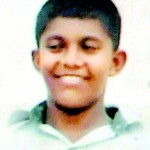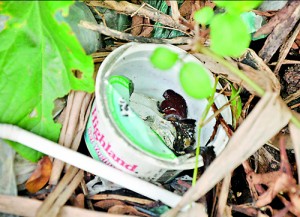News
‘If only …’ grieving mother relates biggest dengue death trap
Thirteen-year-old Imesh’s dream to be a crack motorcycle rider one day was shattered as a deadly mosquito snatched his young life, leaving his parents in shock over the sudden loss of their only son.
Today his mother, B.A. Anoma, wishes she had admitted her son to hospital earlier despite his protests.

B.A. Anoma bemoans the loss of her son Imesh (below). Pix by Indika Handuwala
 “After two days of continuous fever I took him to the closest clinic and the doctor advised me to get a full blood count test if the fever continued,” she said.
“After two days of continuous fever I took him to the closest clinic and the doctor advised me to get a full blood count test if the fever continued,” she said.
“We obtained the report but Imesh refused to go to hospital. He shouted and cried, and I thought in any case the fever would go away and just continued giving him medicine. When the fever receded he went out to play with his friends.
“The second laboratory report came with a red seal on it. It was an emergency. I took him to the hospital, the Homagama Base Hospital.
“But he was in the last stages of dengue fever. The doctors said my son was strong to have been able to bear the pain he was suffering.
“Just hours before he died, he was promising to come home all cured,” the grieving mother said.
Last year, about 3000 children were admitted to the Lady Ridgeway Children’s Hospital (LRH) to be treated for dengue fever; of them, 17 died.
LRH Director Dr. Ratnasiri Hewage told the Sunday Times the main reason for the deaths was that the children had been admitted too late to hospital.
He said schools should take extra safety measures as most of the victims were of schoolgoing age.
“Only two deaths were of children aged under one year; the other 15 were schoolgoing children,” Dr. Hewage said.
Consultant epidemiologist and Director of the National Dengue Control Unit of the Health Ministry, Dr. Hasitha Tissera said that despite clear guidelines and advice to seek medication families showed a lack of concern over the need to get a victim quickly to hospital.
“There have been clear warnings that if fever persists beyond 48 hours people must immediately visit a qualified doctor or go to the nearest hospital. Fever is just a symptom. Dengue’s fever stage is harmless; it may get severe when the fever subsides. If there is vomiting, abdominal pain, bleeding gums and stools there is a possibility that the child or adult will go into shock and that could lead to death,” he said.
Dr. Tissera said that ignoring the fever and trying self-medication – particular traps for young adults – should be avoided.

A mosquito breeding spot
“By self-medicating one is just trying to treat a symptom, that is, fever. Sometimes self-medication leads to overdosing with pain-relieving drugs and this can affect the body’s organs such as the liver. Paracetamol may relieve symptoms of fever and joint pain but drugs such as Ibuprofen and Aspirin may even cause complications,” he said.
Dr. Tissera said rest was important for children. They should be kept at home and given fluids, not only water, but also Jeewani (oral rehydration solution), congee, fresh fruit juices and soup. Warm water sponging was also recommended to relieve the fever.
Dr. Tissera said it had been observed that there was an increase in dengue-infected children from urban schools just after the end of school holidays.
“Applying mosquito repellent on children before sending them to school is just a temporary measure and might not even provide protection. The best thing is to destroy mosquito breeding places within the school premises,” he said.
| Outbreak fears over two active strains
The country is experiencing a dengue hyperendemic disease situation with two serotypes (viruses) active at the same time, the Health Ministry’s National Dengue Control Unit Director, Dr. Hasitha Tissera said. He said the outbreak pattern of increase once every two years could continue. In 2010, there were 246 dengue deaths; the death toll came down to 185 in 2011. Again, in 2012, the toll increased to 225 and last year it came down to 85. “There should be a major drive to prevent the mid-year peak from April to July. As serotype I and IV both are active there is a possibility of an outbreak. Cleaning up, removing discarded containers in which water could collect and preventing dengue breeding sites should be done on a regular basis,” he warned. According to Dr. Tissera residences, schools, abandoned lands, construction sites and garbage dumps should be constantly inspected. Last year, 31,876 dengue cases were reported. Most cases were reported from Colombo district with 10,757 cases, followed by the Gampaha and Kurunegala districts. Most cases come from Dehiwala-Mount Lavinia, Kaduwela, Homagama, Kolonnawa, Wattala, Ja-ela, and Kelaniya.
What is dengue? Dengue is an acute flu-like fever caused by a virus. It can cause disease in two forms: |

